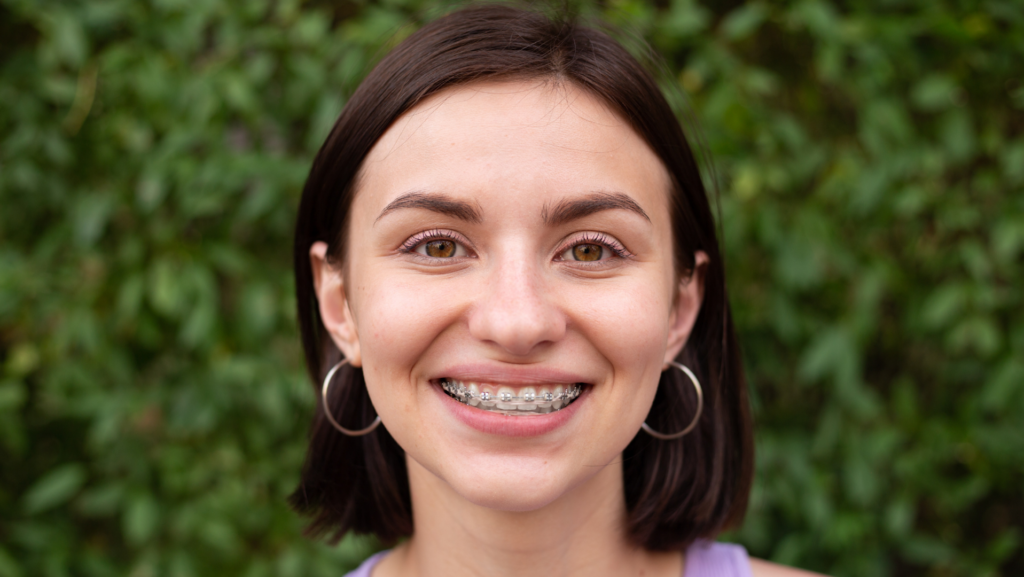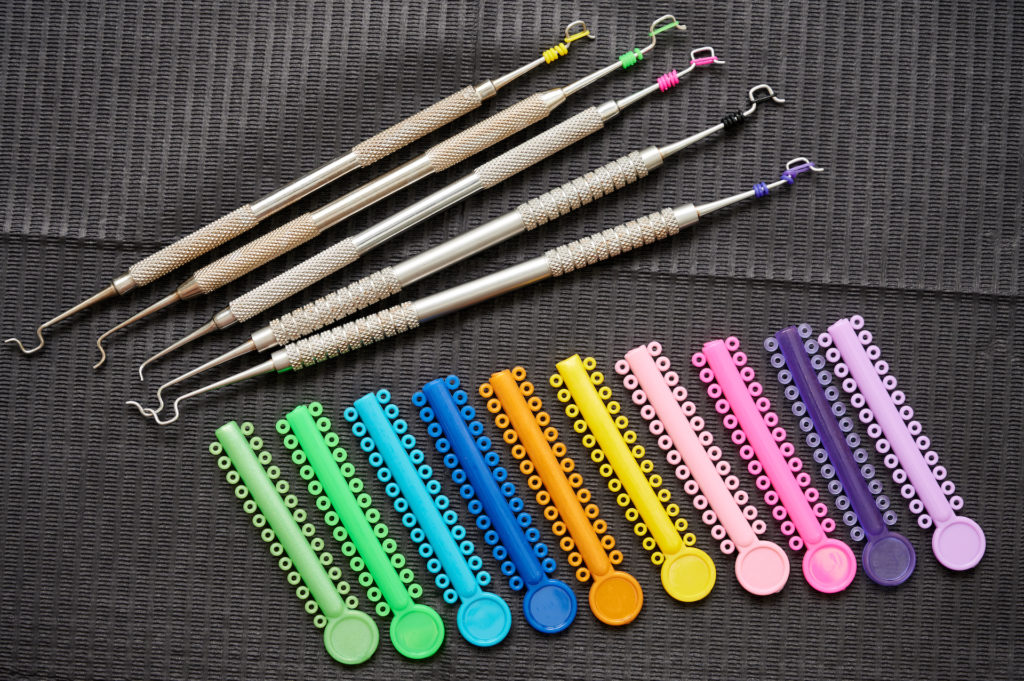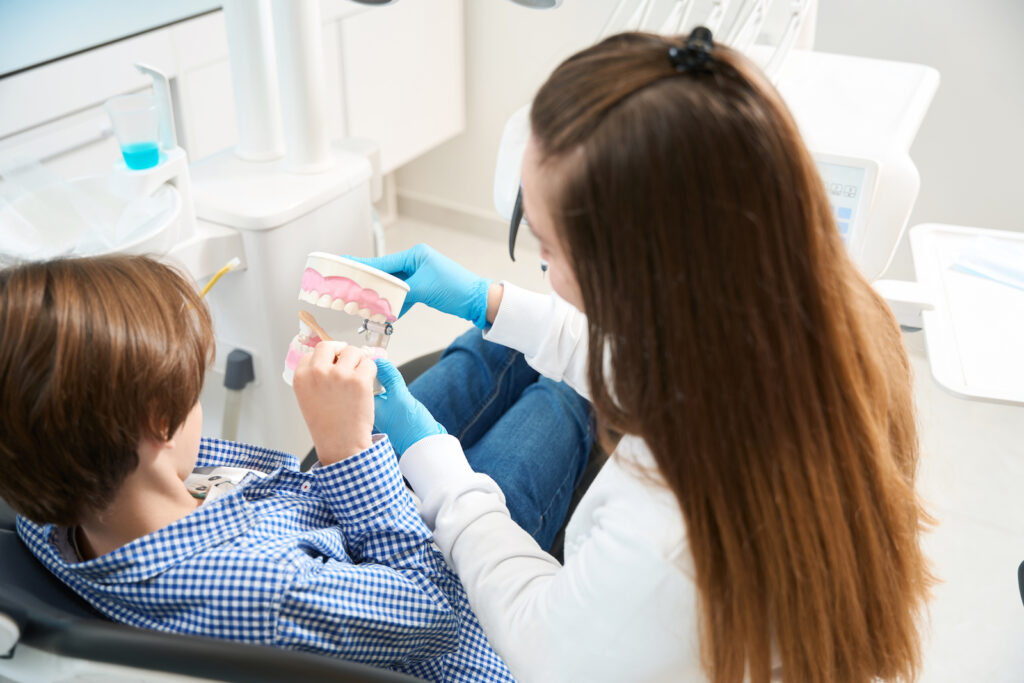This website uses cookies so that we can provide you with the best user experience possible. Cookie information is stored in your browser and performs functions such as recognising you when you return to our website and helping our team to understand which sections of the website you find most interesting and useful.
In the past, braces were fairly simple. They were usually made up of plain silver metals, and patients didn't have much say in how they looked. Nowadays, getting braces is a fun and creative experience. The brackets that make up braces have elastic ligatures, or rubber bands, that come in all sorts of colors. Patients can choose anything they want from light, eye-catching colors to dark, discreet shades.
With so many options, deciding on a single color can be difficult. Ultimately, you want something that suits your unique personality while also making your teeth shine brighter. Let's take a closer look at the available colors and how to pick the right color for you.
What Color Braces Are Available?
When it comes to braces colors, the sky’s the limit. You'll find everything from white and clear elastic bands to striking black and brown bands. In between these two extremes are all the colors of the rainbow, from purple and blue to red and yellow. You can settle on a single color or combine a few — most patients choose between one and two colors.
Many orthodontists offer a color wheel to help patients imagine their braces. This tool shows all of the available colors and helps patients to see the differences between hues. If you're interested in blue braces, for example, the color wheel can help you pinpoint the exact shade of blue you're looking for.
How Often Can I Change My Braces Color?
If you're worried about picking the right braces color, you may be relieved to learn that it's just a temporary decision. Your orthodontist can change out the rubber bands during your adjustment appointment, which generally occurs every 8 to 12 weeks. If you find a color you really like, you can also ask for the same one each time.

What Braces Color Is Right For Me?
There's no single answer to the question, "What color braces should I get?" Instead, the answer depends entirely on what you're looking for. Here are a few factors you could base your decision on.
1) Personal Preferences
The most straightforward way to choose a color is by simply selecting what you like. This could be your favorite color, a popular color combination, or something meaningful to you such as your school or alma mater colors. You should also consider the type of look you're trying to achieve. If you're going for an upbeat look, for example, stick with light, cheerful colors like pink, orange, or red. If you want a more laid-back vibe, cool colors like dark blue, lavender, and silver work well.
2) Seasonal Events/Themes
If you can't settle on a single color, consider changing things up based on the time of year. Are you trying to be festive this holiday season? Go for Christmas colors and get red and green rubber bands. Do you want to flaunt your spooky side for Halloween? Black and orange bands are the way to go. In addition to picking seasonal colors, you could adjust based on events in your life. If you have a sports game coming up, for example, you could pick bands that match your team's colors.
3) Physical Appearance
A great way to figure out the best color for you is by using your appearance. Start by picking a physical feature, then think about which colors go well with that feature. Here are a few starting points to base your braces color on:
- Skin tone. Darker skin tones tend to go well with bright jewel tones, like emerald green, ruby red, and violet. Lighter skin tones match cooler colors like light blue and green.
- Eye color. If you have brown eyes, earthy colors such as blue and green are a great choice. For lighter eyes, you'll want bright colors that can make them pop. Lilac, light blue, and pink tend to go well with lighter eye colors.
- Hair color. As with skin tones, dark hair goes well with bolder jewel tones. In contrast, light blonde hair suits cooler colors.
A helpful way to identify a complementary color is by using a braces color wheel. Start by choosing a certain physical feature, then locate its color on the wheel. Once you've found it, go to the matching color on the opposite side of the wheel. Whatever this color is, it should accentuate your chosen feature. If your dentist does not have a traditional color wheel, you can find one online.
How Bands Can Make Your Smile Look Whiter
Along with considering your general physical appearance, it's important to think about the appearance of your teeth. A common question that many patients ask is: what color braces make my teeth look whiter? If you're interested in whiter teeth, a dark color is the way to go. Darker colors, such as navy blue, dark purple, and black, provide a nice contrast to the natural whiteness of your teeth. This will make your teeth seem even brighter than they are.
What Braces Colors Make Your Teeth Look Yellow?
While some colors can help your teeth seem whiter, others can actually make your teeth look yellow. For example, clear and white braces can become discolored over time, causing a yellow appearance. Yellow and gold braces can look like stains or discoloration, so you probably want to avoid those colors.

What to Keep In Mind When Picking the Colors of Braces
Here are a few general tips to keep in mind when trying to find the best braces color:
- Avoid natural-looking colors. Try to avoid natural-looking bands that resemble food. Colors like brown and dark green can make it seem like you have meat or spinach stuck in your teeth.
- Follow good oral health habits. While going for a dark color can help your teeth appear more white, the best way to maintain a bright smile is through proper oral hygiene. Regular brushing and flossing will help prevent unwanted tooth discoloration.
- Get creative. Colored braces are a great way to show off your creativity. Don't be afraid to experiment with different colors and try something new during your next appointment!
Along with picking a good color, it's important to work with a reputable team. At Risas Dental, we always put patients first. Whether you're trying to make your teeth seem whiter or need advice on a color combination for your child, you can count on us for expert advice.
Frequently Asked Questions
The most popular colors for braces vary depending on age and gender. Adults tend to go for more discreet options, like white and clear braces. On the other hand, children often pick colorful braces. Some prefer pink or light blue, while others choose darker colors like deep red and navy blue.
If you want to maintain a professional look, try to avoid braces colors that are too bright (such as hot pink or light purple). Many working adults opt for neutral colors, like silver or white. Dark tones also provide a professional look and have the added bonus of making your teeth look whiter.
While braces are usually the recommended option for children, adults may use an alternative, such as clear aligners. Unlike braces that use metal/porcelain, wires, and rubber bands, aligners are made of plastic. Customized to fit your mouth, they gently move teeth over time. As long as your teeth are not too crooked, aligners are generally a viable option. But because they don't use elastics, you can't change the color — they're always clear.
Answering the question "what color braces should I get?" is no easy feat. If you still need guidance, our teammates are happy to help! We'll walk you through your options, answer any questions, and recommend a color that best suits your needs. Our dedicated bilingual team, affordable plans, and patient-first mentality helps us stand out from the crowd.
Getting braces is an exciting adventure for anyone who wants a straighter and healthier smile. However, most people don’t realize there is a lifestyle change that happens when you first get braces. When considering the adjustment period, which usually lasts for a couple of weeks, summer is the ideal time to take the first step into your life-changing smile transformation.
Things to Consider When Getting Braces
Summer months typically offer more flexibility when scheduling appointments and adjusting to any initial discomfort that can be expected when first getting braces. Paired with fewer academic and extracurricular commitments, it can be easier to accommodate necessary orthodontics appointments without extra stress.
Patients getting braces for the first time are often surprised by the various changes to their routine. Some changes patients can experience are:
Soreness: It is normal to experience some soreness the first few days after first getting braces. It means your braces are working! Your body just isn’t used to having metal in your mouth, and there’s a lot of pressure on your teeth, gums, and jaw. However, this is not a reason to be afraid of or avoid getting braces, and there are many ways to relieve pain and make your smile transformation more comfortable including oral anesthetics, pain medication, ice packs…and did we mention ice cream?
Eating: While eating certain foods can be challenging due to soreness, that’s not the only challenge with eating. Learning how to eat with braces on your teeth is hard to understand until you’ve experienced it for yourself! Initially, it can be intimidating to bite down on harder foods when you are learning how strong or fragile your brackets, wires, and bands are. Eating becomes much easier once you get past the initial adjustment.
Speaking: Have you ever tried saying a sentence with something in your mouth? That’s kind of what having braces is like. It’s common for some patients to produce more saliva during their initial adjustment, as they are adapting to a new object in their mouth, but this is not permanent. Additionally, it can be difficult to enunciate some letters without some practice.

Is getting braces hard to get used to?
While all these factors can be intimidating, it is important to remember that they are temporary. Most patients adjust to having braces within two weeks, but some patients can take up to a month to adapt to their new lifestyle.
Ultimately, summer provides a convenient and comfortable time to get braces, making it easier to adapt to any changes and make progress towards a straighter, healthier smile.
Next Steps for Getting Braces
Additionally, beginning treatment in the summer allows patients time to get used to their braces before the holiday season, allowing them to fully enjoy festivities without worrying about the initial challenges of braces. Although some discomfort is expected with adjustments, many patients find the first one to be the most challenging.
Are you ready to start your smile transformation this summer? Is your teenager ready to say hello to their dream smile? We want to make your braces transition as easy as possible! Learn more about our summer giveaway for new orthodontics patients.
Frequently Asked Questions
When is the best age for getting braces?
Once a child has their full set of permanent teeth, it is a good time to come in for an orthodontic consultation. While it is most common for teenagers to get braces, it is normal for adults get braces as well.
How long do braces stay on?
That amount of time your orthodontic treatment takes can vary based on several factors such as how overcrowded your teeth are, if you have an overbite, and how well you follow your doctor’s recommended treatment and oral care instructions. Most common treatment plans take 1 – 3 years.
Do you get braces on your first visit?
If you come in for a orthodontic consultation at our office, our Orthondist will first propose a treatment plan with costs. If you are a candidate for braces and agree to start, you will be scheduled to start braces at your next appointment.
Orthodontics refers to the treatment of dental irregularities including alignment of the teeth and jaws. In addition to straightening the teeth, orthodontics for kids can improve chewing function, make it easier to clean your teeth, and suppress symptoms of TMJ.
Straightening your teeth is an important decision to make and once you make the choice to do it, there is still one more question: Braces vs. Clear Aligners, what type of orthodontic treatment is best for me? The best way to answer this question is by having a conversation with your orthodontist.
